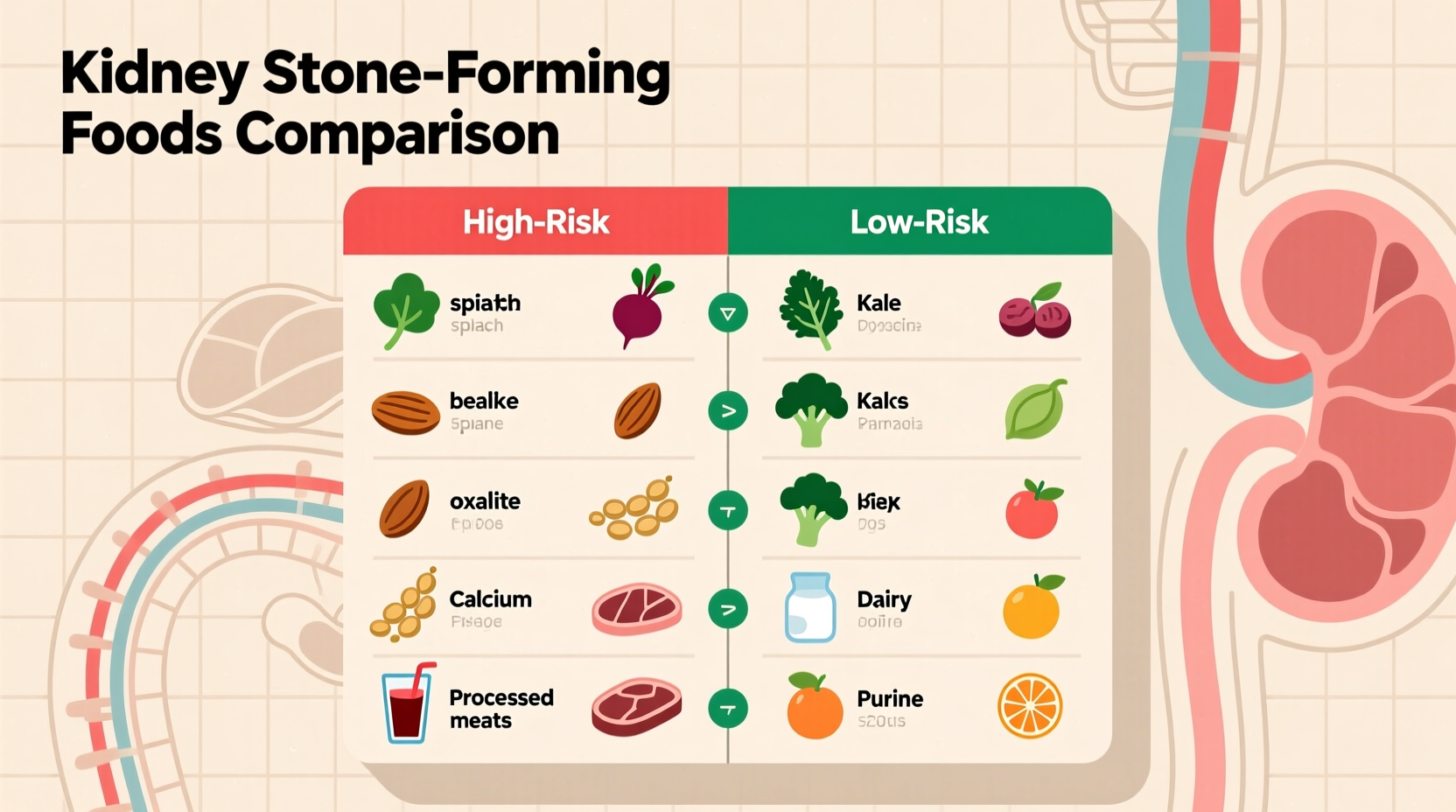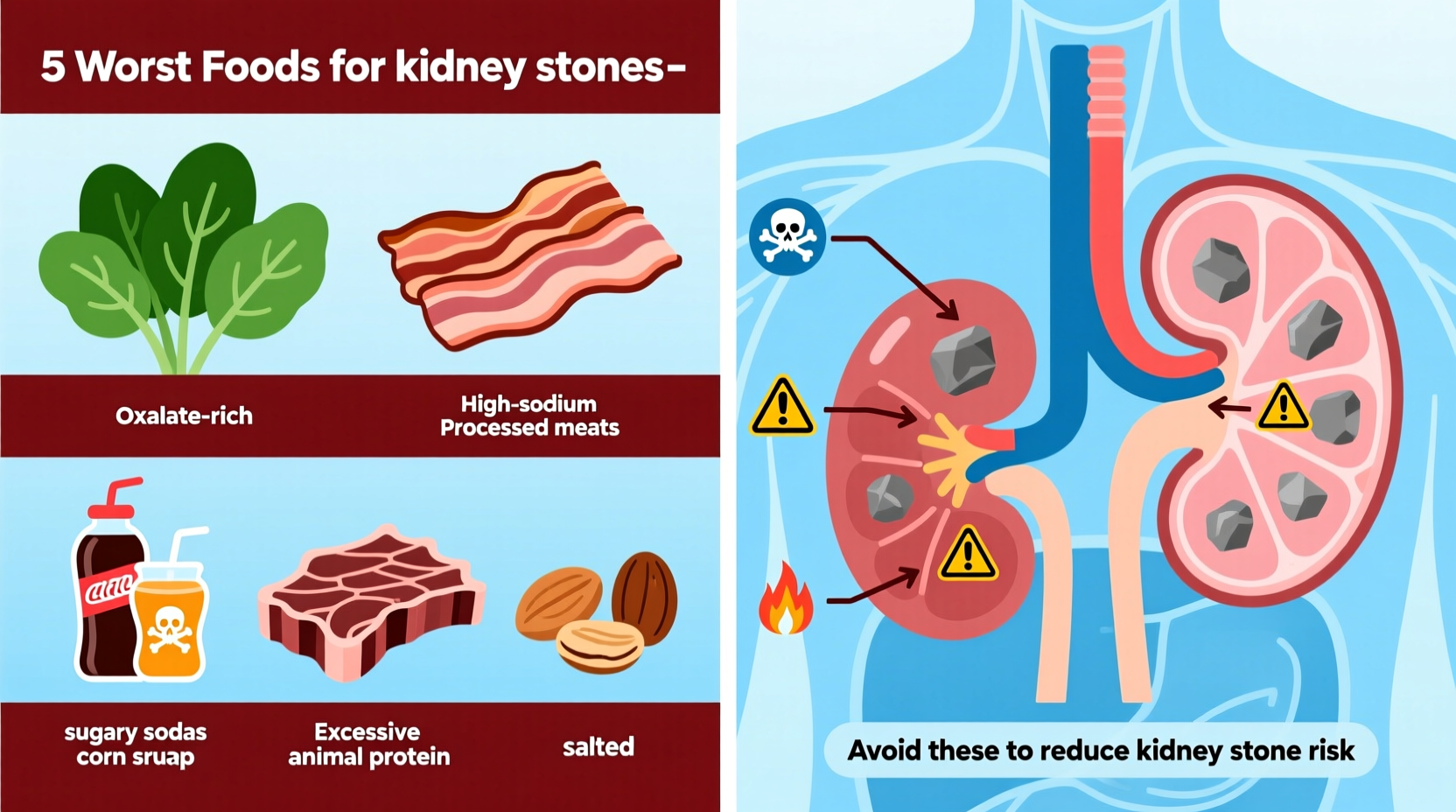If you're concerned about kidney stones, immediately avoid these top offenders: spinach, nuts, beets, chocolate, and high-sodium processed foods. Research from the National Kidney Foundation shows dietary changes can reduce kidney stone recurrence by up to 50%. This evidence-based guide details exactly which foods worsen stone formation and provides practical alternatives you can implement today.
Understanding Kidney Stone Formation: Why Food Choices Matter
Approximately 1 in 10 Americans will develop kidney stones during their lifetime, with recurrence rates as high as 40% within five years. Kidney stones form when minerals and salts crystallize in your kidneys, often due to concentrated urine. While genetics play a role, your diet significantly influences risk—particularly for the most common calcium oxalate stones, which account for 80% of cases.
The National Institute of Diabetes and Digestive and Kidney Diseases (NIDDK) confirms that dietary modifications represent the first line of defense against stone formation. "What you eat directly affects the chemical composition of your urine," explains Dr. John Rodman of the American Urological Association. "By understanding which foods increase stone risk, you can make targeted changes that yield measurable results."
High-Oxalate Foods: The Primary Culprit
Oxalate binds with calcium in your urine, forming crystals that develop into stones. While some oxalate consumption is normal, excessive intake significantly increases risk. The following foods contain particularly high concentrations:
| Food | Milligrams of Oxalate per Serving | Safer Alternatives |
|---|---|---|
| Spinach (½ cup cooked) | 656 mg | Kale (2 mg per cup) |
| Almonds (1 oz) | 122 mg | Pumpkin seeds (15 mg per oz) |
| Beets (½ cup) | 75 mg | Carrots (5 mg per cup) |
| Dark chocolate (1 oz) | 52 mg | White chocolate (0 mg) |
This comparison, based on USDA nutrient data and NIDDK research, shows why substituting high-oxalate foods matters. The Mayo Clinic recommends limiting daily oxalate intake to 50-100 mg for stone formers, compared to 150-250 mg for the general population.

Sodium Overload: The Hidden Stone Builder
Excess sodium forces your kidneys to excrete more calcium into urine—directly increasing stone risk. The American Kidney Fund reports that high sodium intake can increase calcium stone risk by 25-30%. Problematic sources include:
- Processed meats (deli meats, bacon, sausage)
- Canned soups and broths
- Pickled foods and olives
- Fast food and restaurant meals
- Salted snack foods
A single restaurant meal can contain 3,000+ mg of sodium—more than double the recommended daily limit of 1,500 mg for stone prevention. The Dietary Guidelines for Americans emphasizes that 70% of our sodium comes from processed and restaurant foods, not the salt shaker.
Animal Proteins and Purine-Rich Foods
High consumption of animal proteins increases uric acid production and reduces citrate—a natural stone inhibitor—in urine. The Journal of Urology published research showing that reducing animal protein intake by just 10% decreased stone recurrence by 14%.
Specific concerns include:
- Red meat (beef, pork, lamb)
- Organ meats (liver, kidney)
- Shellfish (shrimp, lobster, mussels)
- Game meats
For those prone to uric acid stones (10% of cases), these foods represent particular risk. The National Kidney Foundation recommends limiting animal protein to 6 ounces daily—about the size of a deck of cards.
Sugary Beverages and Fructose
Soda and sweetened beverages increase stone risk through multiple mechanisms. A Harvard study tracking 194,095 participants found that those consuming just one sugar-sweetened cola daily had a 23% higher risk of developing stones.
Why sugar matters:
- Fructose increases urinary calcium excretion
- Sugary drinks reduce urine volume
- High-fructose corn syrup directly stimulates stone formation
The American College of Physicians specifically recommends avoiding sugar-sweetened beverages as a primary prevention strategy. Water remains the gold standard for stone prevention—aim for enough fluid to produce 2.5 liters of urine daily.
Practical Dietary Adjustments You Can Implement Today
Complete elimination of certain foods isn't necessary—strategic modifications yield the best results. Based on clinical guidelines from the American Urological Association, try these evidence-based approaches:
Smart Substitution Strategies
- Replace spinach in salads with lettuce or cabbage
- Choose low-oxalate nuts like macadamias instead of almonds
- Use herbs and spices instead of salt for flavoring
- Pair calcium-rich foods with high-oxalate foods to bind oxalate in the gut
Meal Planning Framework
Follow this simple template for stone-preventive meals:
- Protein: 3-4 oz lean poultry or plant-based protein
- Vegetables: 2 cups low-oxalate options (broccoli, cauliflower, cucumbers)
- Grains: ½ cup whole grains (quinoa, brown rice)
- Fat: 1 tsp olive oil or avocado
- Beverage: 8 oz water with lemon (citrate helps prevent stones)
Individual Factors That Modify Dietary Needs
Your specific stone type determines which foods pose the greatest risk. While calcium oxalate stones are most common, other types require different approaches:
- Calcium phosphate stones: Focus on reducing sodium rather than oxalate
- Uric acid stones: Prioritize limiting animal proteins and purine-rich foods
- Struvite stones: Often infection-related, with less dietary influence
- Cystine stones: Genetic condition requiring specialized medical management
The American Kidney Fund emphasizes that 24-hour urine testing provides the most personalized dietary guidance. "Without testing, you're guessing at your specific risk factors," notes Dr. Kristina Penniston, a leading nutrition researcher in urology.
When to Consult a Healthcare Professional
Dietary changes work best as part of a comprehensive prevention strategy. Consult a healthcare provider if:
- You've passed one or more stones
- You experience recurrent urinary tract infections
- You have a family history of kidney stones
- You notice blood in your urine
Medical evaluation may include urine testing, blood work, and imaging to determine your specific stone risk profile. For recurrent stone formers, the American Urological Association recommends formal metabolic evaluation to guide personalized prevention.











 浙公网安备
33010002000092号
浙公网安备
33010002000092号 浙B2-20120091-4
浙B2-20120091-4